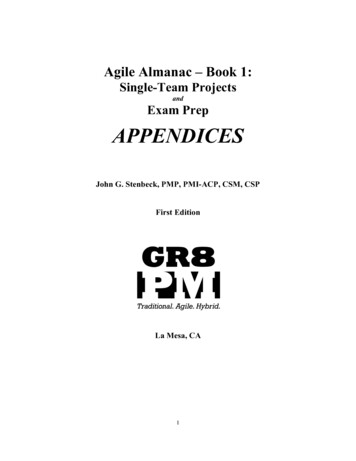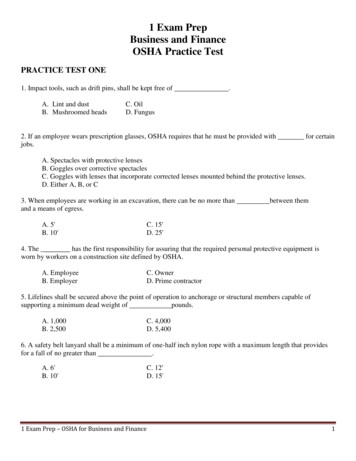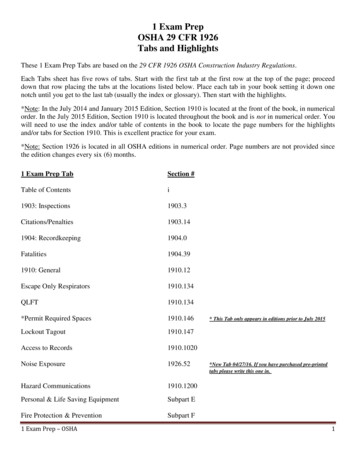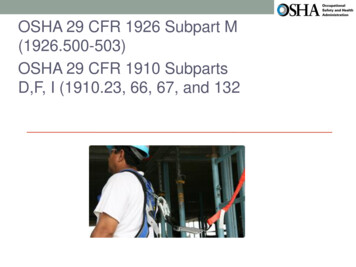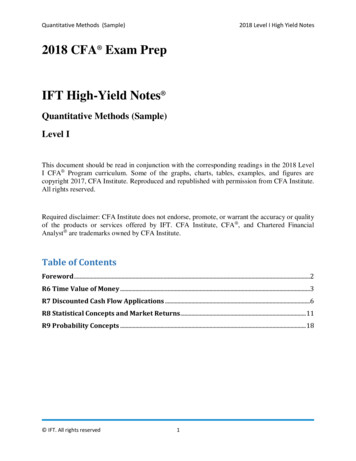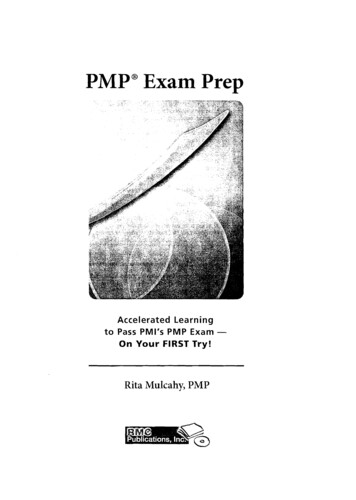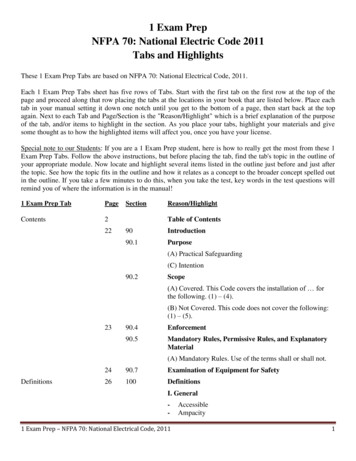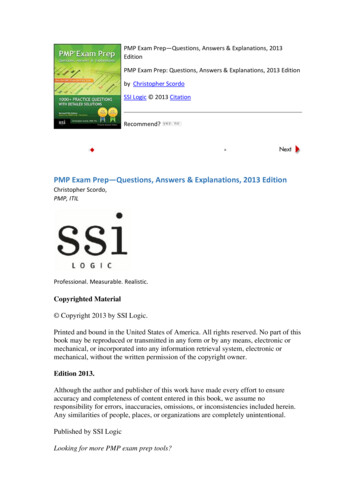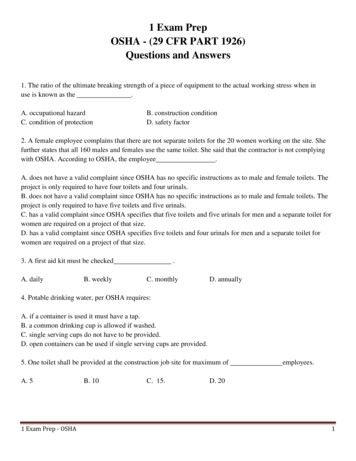
Transcription
1 Exam PrepOSHA - (29 CFR PART 1926)Questions and Answers1. The ratio of the ultimate breaking strength of a piece of equipment to the actual working stress when inuse is known as the.A. occupational hazardC. condition of protectionB. construction conditionD. safety factor2. A female employee complains that there are not separate toilets for the 20 women working on the site. Shefurther states that all 160 males and females use the same toilet. She said that the contractor is not complyingwith OSHA. According to OSHA, the employee.A. does not have a valid complaint since OSHA has no specific instructions as to male and female toilets. Theproject is only required to have four toilets and four urinals.B. does not have a valid complaint since OSHA has no specific instructions as to male and female toilets. Theproject is only required to have five toilets and five urinals.C. has a valid complaint since OSHA specifies that five toilets and five urinals for men and a separate toilet forwomen are required on a project of that size.D. has a valid complaint since OSHA specifies five toilets and four urinals for men and a separate toilet forwomen are required on a project of that size.3. A first aid kit must be checkedA. dailyB. weekly.C. monthlyD. annually4. Potable drinking water, per OSHA requires:A. if a container is used it must have a tap.B. a common drinking cup is allowed if washed.C. single serving cups do not have to be provided.D. open containers can be used if single serving cups are provided.5. One toilet shall be provided at the construction job site for maximum ofA. 51 Exam Prep - OSHAB. 10C. 15.employees.D. 201
6. Given the following:1-1/2 hr noise exposure at 90 dBA1/2 hr noise exposure at 100 dBA1/2 hr noise exposure at 105 dBAIf your employees are exposed to all of the above noise levels each work day, then according to OSHA the"equivalent noise exposure factor":A. exceeds unity, therefore the noise exposure is within permissible levelsB. exceeds unity, therefore the noise exposure is not within permissible levelsC. Does not exceed unity, therefore the noise exposure is within permissible limitsD. does not exceed unity, therefore the noise exposure is not within permissible limits.7. Exposure to impact or impulsive noise should not exceedA. 120B. 130C. 140dB peak sound pressure.D. 158. Construction areas, aisles, stairs and ramps and storage areas for workers shall be lighted.A. with natural illumination onlyB. only if hazardous conditionsC. only if the job superintendent deems it necessary.D. with natural or artificial illumination9. According to OSHA, the minimum illumination of indoor corridors during construction iscandles.A. 3B. 5C. 10footD. 3010. Regarding personal protection life saving equipment, OD refers to.A. over designB. outside perimeterC. optical densityD. operating difficulty.11. According to OSHA, life lines used for employee safeguarding shall have a minimum breaking strengthofpounds.A. 500 poundsB.4000C.3500D.540012. The maximum distance a man wearing a safety belt may drop or work is:A. 3 feet1 Exam Prep - OSHAB. 6 feetC. 12 feetD. 15 feet2
13. When working with scaffolds over water what precaution is required?A. ever worker must wear safety shoesB. all personnel should be instructed in life savingC. all personnel should be wearing a life jacket or floatation, vestD. scaffolds should not be build over water without safety nets14. According to OSHA, a fire extinguisher rated not less than 2A shall be provided for each(maximum) of the protected building area.A. 1500 sq. ft.B. 2000 sq. ft.C. 2500 sq. ft.D. 3000 s15. A fire breaks out in a main electrical junction box at a construction site, an electrician is lose by and asksyou to get a fire extinguisher. According to OSHA, which of the following extinguishers should you bringback?A. soda acidC. stored pressure (water type)B. foamD. CO216. A class A fire consists of burningA. woodC. electrical equipment.B. oilD. metals17. According to OSHA, material shall not be stored withinA. 24 inchesB. 30 inchesC. 36 inchesinches from a fire door:D. 48 inches18. According to OSHA, no more thangallons of flammable or combustible liquids shall bestored in a room outside of an approved storage cabinet.A. 10 gallonsB. 15 gallonsC. 20 gallonsD. 25 gallons19. According to OSHA, a sign lettered in legible red letters, not less than 6 inches high on a white fieldis used only as a/ansign.A. dangerB. exitC. cautionD. safety instructional20. Material stored inside building under construction shall not be placed withinopening or inside floor openings.A. 4’1 Exam Prep - OSHAB. 5’C. 6’of any hoistwayD. 10’3
21. Wire rope shall not be used if in any strength of 8 diameters the total number of visible broken wiresexceed% of the total number of wires.A. 5B. 10C. 15D. 2022. According to OSHA, scaffolds and their components shall be capable of supporting without failure atleasttimes their maximum intended load.A. 2B. 3C. 4D. 523. Scaffold planks shall extend over end supports not lessA. 6---12B. 8---12C. 9---1224. A standard toe board shall be a minimum ofA. 3 inchesB. 3- 1/2 inchesC. 4 inchesinches and not more thaninches.D. 10---16inches high.D. 4- 1/2 inches25. According to OSHA, the maximum permissible span for 2 x 10 inch planks used on scaffolding with aworking load of 75 psf isfeet. Assume full thickness, undressed lumber is used.A. 10B. 8C. 6D. 426. A gap or void 2 inches or more in its least dimension in a floor, roof, or other walking/working surfaceis a.A. toe holeB. floor holeC. breechD. opening27. According to OSHA, every open sided floor or platform (other than scaffolding)feet or moreabove adjacent floor or ground level shall be guarded by a standard railing, or the equivalent, on all open sides,except where there is entrance to a ramp, stairway or fixed ladder.A. 6 feetB. 8 feetC. 10 feetD. 12 feet28. The vertical height of a guard rail shall be:A. 30 inchesB. 36 inchesC. 42 inchesD. 48 inches29. Where electrical transmission lines are energized and rated at least 50 KV or less, a clearanceoffeet minimum must be maintained by the crane and load.A. 5 feet1 Exam Prep - OSHAB. 8 feetC. 10 feetD. 12 feet4
30. According to OSHA safety and health regulation for construction, the minimum diameter wire ropes used inpersonnel hoists shall beinch.A. ½B. 5/8C. ¾31. When employees are required to be in trenchesprovided for exit, and such ladders shall require not more thanA. 4 feet-30 feetC. 4 feet-25 feetD. 7/8feet or more in depth, ladders shall befeet of lateral travel.B. 5 feet- 30 feetD. 5 feet-25 feet32. According to OSHA, when materials are dropped more thana building an enclosed chute must be utilized:A. 10 feetB. 15 feetC. 20 feetfeet outside the exterior walls ofD. 25 feet33. An electric power circular saw according to OSHA must be:A. equipped with a constant pressure on switchB. equipped with a momentary on/off switch that may have a lock on controlC. equipped with a positive on/off control,D. none of the above34. For general cleaning operations air pressure must be reduced to less thanA. 15B. 20C. 15psi.D. 3035. Portable electrical tools do not have to be grounded if.A. they operate at less than 50 voltsB. equipped with a momentary on/off switch that may have lock on controlC. equipped with a positive on/off controlD. none of the above36. Referring to power actuated tools, fasteners can be driven intoA. face brickC. cast iron1 Exam Prep - OSHA.B. surface hardened steelD. none of the above5
37. According to OSHA, oxygen cylinders, regulators, and hoses shall be:A. stored only in approved containersB. prohibited in areas where fuel gasses other than acetylene are usedC. unpaintedD. kept free of all oil or grease38. Class II hazardous locations are those with a presence of:A. combustible dustC. flammable liquidsB. ignitable fibersD. explosives39. When employees are required to be in trenches ofa ladder or steps shall be provided.A. 3 feetB. 4 feetor more, an adequate means of exit such asC. 5 feetD. 6 feet40. In excavations where employees must enter, excavated or other materials may be stored:A. two feet from the edge of the excavationB. one foot from the edge of the excavation if properly retainedC. one foot from the edge of the excavationD. A or B41. The greatest angle above the horizontal plane for Type A soil isA. 34 degreesB. 45 degreesC. 53 degrees42. Sloping or benching for excavation thanprofessional engineer.A. 10B. 15degrees.D. 90 degreesfeet deep shall be designed by a registeredC. 20D. 2543. OSHA requires that for skeleton steel construction no more thanunfurnished bolting or welding exist:A. 20 and 21 Exam Prep - OSHAB. 24 and 2C. 30 and 3feet orfloors ofD. 48 and 46
44. The term "ROPS" means:A. regional operating standardsB. required operating stepsC. roll over protective structuresD. none of the above45. According to OSHA, temporary stairs shall have a landing not less than 30" in the direction of travel atevery(maximum) of vertical rise.A. 8'B. 10'C. 12'D. 16'46. Temporary stairs shall be installed at angles to the horizontal of betweenA. 20 and 40B. 20 and 50C. 20 and 30anddegrees.D. 30 and 5047. According to OSHA, stairway railings shall be of such construction, to be capable of withstanding aminimum load ofpounds applied in any direction at any point the top rail.A. 100B. 150C. 200D. 25048. Rungs, cleats and steps of portable ladders (except for special applications such as step-stools) shall bespaced not less thaninches, nor more thaninches.A.8-11B.8-14C. 10-14D. 12-1649. The minimum clear distance between the side rails of all portable ladders shall not be lessthaninches.A. 11 ½B. 12C. 13D. 1450. A 27 foot ladder that extends the required distance above the landing should have a horizontal distance fromthe top support to the foot of the ladder offeet.A. 4B. 5C. 6D. 851. What is the maximum base dimension for a 24 foot long cleat ladder with a top side rail spacing of 20inches? Assume the side rail flare from top to bottom by not more than ¼ inch per each 2 feet of length.A. 20”1 Exam Prep - OSHAB. 21”C. 22”D. 23”7
52. The Code of Federal Regulations, 1926.1060, requires an employer to provide a training program for eachemployee:A. using ladders and stairwaysB. working with toxic substancesC. working in excavationsD. using scaffolding53. Safety nets, where required, shall be provided when workplaces are more thanground or water surface.feet above theA. 100B. 75C. 50D. 251 Exam Prep - OSHA8
OSHA Answer SheetPARAGRAPH 19261. D2. A3. B4. A5. D6. C7. C8. D9. B10. C11. D12. B13. C14. D15. D16. A17. C18. D19. B20. C21. B22. C23. A24. B25. C26. B27. A32(n)Tb D-150(d)(2)51(a)(2)&(5)Tb D-152 Tb54056456 Tb D-3102(b)(24104(b)104(d)106(a)150(c)Tb F-1Tb 51(a)(1)451(b)(4) & (5)451(h)(4)iiSub. L, App. A500(b)501(b)(2)ii1 Exam Prep - OSHA28. C29. C30. A31. C32. C33. A34. D35. D36. D37. D38. A39. B40. D41. C42. C43. D44. C45. C46. D47. C48. C49. A50. C51. D52. A53. 2(b)(4)302(a)302(e)(7)350(i)449651(c)(2)651(j) (2)Tb B-1.Tb B-1 3(a)(3)1053(a)(4)1053(b)(1)1926.1060 (a)1926.105 (a)9
18. According to OSHA, no more than gallons of flammable or combustible liquids shall be stored in a room outside of an approved storage cabinet. A. 10 gallons B. 15 gallons C. 20 gallons D. 25 gallons 19. According to OSHA, a sign lettered in legible red letters, not less than 6 inches high on a white fieldFile Size: 324KBPage Count: 9
